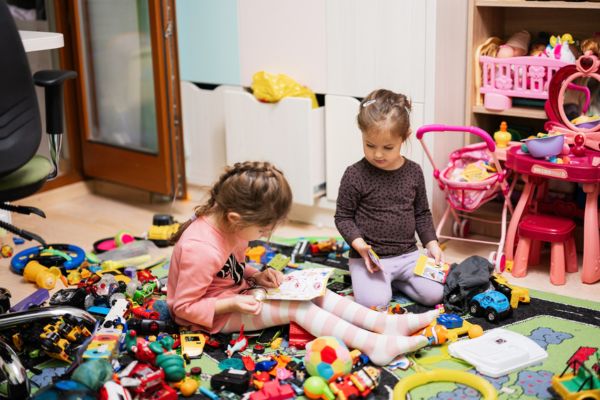
Often when faced with a child’s challenging behavior we think, “How can I help them change that behavior?” In many situations, the question we should be asking is, “How can I change the environment to support this child and their challenges?” When kids are learning a new skill, including emotion and behavior management, they need a safe space to practice, fail, learn from the experience and practice some more. That cycle is how we all learn to do anything and everything. We can change the environment to support them through that cycle rather than have the environment continue to work against them. Here’s an example we’ve all faced at one time or another.
Challenge: Three-year-old Amy just won’t clean up. When she’s finished playing in the playroom, every toy is out and she’s enjoyed each one. When it’s time to put things away, even with a 5-minute warning, she puts one toy away slowly then just refuses to do anything else. She doesn’t yell or cry or stomp her feet, she simply sits on the floor and says, “No.”
Solution: Time to change the environment! Rather than try and cajole her into helping, you simply put the toys away yourself and later, when everything is calm, you explain that because it looks like it’s just too hard for her to help put the toys away at the end of a play session, the next time she’ll only be allowed to play with some of her toys. The rest will be put away waiting for their turn to be played with. Short and sweet – no need for lectures.
The approach, explained:
- Although this may sound like a punishment on the surface, it isn’t. You really do believe for whatever reason, that picking up is beyond where she is at emotionally right now. (If you don’t believe that, work on it… getting in the right mind space is essential).
- You’re not taking toys away because she was “bad,” you’re removing the overwhelm that happens when she takes out a lot of toys at once.
- And finally, you’re managing your annoyance and impatience by limiting the amount of clean up you have to do while Amy is growing and developing into an awesome cleaner.
As you work with her on this skill, you may slowly allow more and more toys out at once. Alternatively, you may discover that limiting the number of toys works best for her and you develop a permanent system around that. Whatever the outcome, you’re supporting her in the way that works best for her.
This approach can be applied on many situations a caregiver faces. Remember, this isn’t about taking things away and then moving on. It’s about noticing the environment and limiting the impactful elements while you help the child learn to manage their emotions and behaviors.